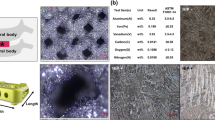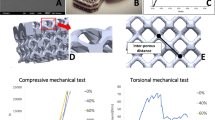Abstract
Polyetheretherketone (PEEK) is a novel polymer with potential advantages for its use in demanding orthopaedic applications (e.g. intervertebral cages). However, the influence of a physiological environment on the mechanical stability of PEEK has not been reported. Furthermore, the suitability of the polymer for use in highly stressed spinal implants such as intervertebral cages has not been investigated. Therefore, a combined experimental and analytical study was performed to address these open questions. A quasi-static mechanical compression test was performed to compare the initial mechanical properties of PEEK-OPTIMA polymer in a dry, room-temperature and in an aqueous, 37°C environment (n=10 per group). The creep behaviour of cylindrical PEEK polymer specimens (n=6) was measured in a simulated physiological environment at an applied stress level of 10 MPa for a loading duration of 2000 hours (12 weeks). To compare the biomechanical performance of different intervertebral cage types made from PEEK and titanium under complex loading conditions, a three-dimensional finite element model of a functional spinal unit was created. The elastic modulus of PEEK polymer specimens in a physiological environment was 1.8% lower than that of specimens tested at dry, room temperature conditions (P<0.001). The results from the creep test showed an average creep strain of less than 0.1% after 2000 hours of loading. The finite element analysis demonstrated high strain and stress concentrations at the bone/implant interface, emphasizing the importance of cage geometry for load distribution. The stress and strain maxima in the implants were well below the material strength limits of PEEK. In summary, the experimental results verified the mechanical stability of the PEEK-OPTIMA polymer in a simulated physiological environment, and over extended loading periods. Finite element analysis supported the use of PEEK-OPTIMA for load-bearing intervertebral implants.






Similar content being viewed by others
Notes
PEEK-OPTIMA is a specific medical grade of PEEK, supplied for use in human implantable devices.
References
Abu Bakar MS, Cheng MH, Tang SM, Yu SC, Liao K, Tan CT, Khor KA, Cheang P (2003) Tensile properties, tension–tension fatigue and biological response of polyetheretherketone-hydroxyapatite composites for load-bearing orthopedic implants. Biomaterials 24:2245–2250
Akay M, Aslan N (1995) An estimation of fatigue life for a carbon fibre/poly ether ether ketone hip joint prosthesis. Proc Inst Mech Eng [H] 209:93–103
Akay M, Aslan N (1996) Numerical and experimental stress analysis of a polymeric composite hip joint prosthesis. J Biomed Mater Res 31:167–182
Albert K, Schledjewski R, Harbaugh M, Bleser S, Jamison R, Friedrich K (1994) Characterization of wear in composite material orthopaedic implants. Part II: The implant/bone interface. Biomed Mater Eng 4:199–211
ASTM D2990–01 (2004) Standard test methods for tensile, compressive, and flexural creep and creep-rupture of plastics
ASTM D695–02 (2004) Standard test method for compressive properties of rigid plastics
Baidya KP, Ramakrishna S, Rahman M, Ritchie A (2001) Quantitative radiographic analysis of fiber reinforced polymer composites. J Biomater Appl 15:279–289
Brown SA, Hastings RS, Mason JJ, Moet A (1990) Characterization of short-fibre reinforced thermoplastics for fracture fixation devices. Biomaterials 11:541–547
Chabrier F, Lloyd CH, Scrimgeour SN (1999) Measurement at low strain rates of the elastic properties of dental polymeric materials. Dent Mater 15:33–38
Cho DY, Liau WR, Lee WY, Liu JT, Chiu CL, Sheu PC (2002) Preliminary experience using a polyetheretherketone (PEEK) cage in the treatment of cervical disc disease. Neurosurgery 51:1343–1349
Cook SD, Rust-Dawicki AM (1995) Preliminary evaluation of titanium-coated PEEK dental implants. J Oral Implantol 21:176–181
Cripton PA (1993) Compressive characterization of ultra high molecular weight polyethylene with applications to contact stress analysis of total knee replacments. MSc Thesis, Queen’s University
Diedrich O, Kraft CN, Perlick L, Schmitt O (2001) The posterior lumbar interbody fusion with cages (PLIF) and transpedicular stabilization. Zentralbl Neurochir 62:106–113
Frei H, Oxland TR, Rathonyi GC, Nolte LP (2001) The effect of nucleotomy on lumbar spine mechanics in compression and shear loading. Spine 26:2080–2089
Grant JP, Oxland TR, Dvorak MF (2001) Mapping the structural properties of the lumbosacral vertebral endplates. Spine 26:889–896
Hunter A, Archer CW, Walker PS, Blunn GW (1995) Attachment and proliferation of osteoblasts and fibroblasts on biomaterials for orthopaedic use. Biomaterials 16:287–295
Jockisch KA, Brown SA, Bauer TW, Merritt K (1992) Biological response to chopped-carbon-fiber-reinforced peek. J Biomed Mater Res 26:133–146
Katoozian H, Davy DT, Arshi A, Saadati U (2001) Material optimization of femoral component of total hip prosthesis using fiber reinforced polymeric composites. Med Eng Phys 23:503–509
Katzer A, Marquardt H, Westendorf J, Wening JV, von FG (2002) Polyetheretherketone–cytotoxicity and mutagenicity in vitro. Biomaterials 23:1749–1759
Krammer M, Dietl R, Lumenta CB, Kettler A, Wilke HJ, Buttner A, Claes L (2001) Resistance of the lumbar spine against axial compression forces after implantation of three different posterior lumbar interbody cages. Acta Neurochir (Wien) 143:1217–1222
Kurtz SM, Villarraga ML, Herr MP, Bergstrom JS, Rimnac CM, Edidin AA (2002) Thermomechanical behavior of virgin and highly crosslinked ultra-high molecular weight polyethylene used in total joint replacements. Biomaterials 23:3681–3697
Lee KY, Pienkowski D (1998) Compressive creep characteristics of extruded ultrahigh-molecular-weight polyethylene. J Biomed Mater Res 39:261–265
Maharaj G, Bleser S, Albert K, Lambert R, Jani S, Jamison R (1994) Characterization of wear in composite material orthopaedic implants. Part I: the composite trunnion/ceramic head interface. Biomed Mater Eng 4:193–198
Matge G (2002) Cervical cage fusion with 5 different implants: 250 cases. Acta Neurochir (Wien) 144:539–549
Meyer MR, Friedman RJ, Del SH Jr, Latour RA Jr (1994) Long-term durability of the interface in FRP composites after exposure to simulated physiologic saline environments. J Biomed Mater Res 28:1221–1231
Morgan EF, Keaveny TM (2001) Dependence of yield strain of human trabecular bone on anatomic site. J Biomech 34:569–577
Morrison C, Macnair R, MacDonald C, Wykman A, Goldie I, Grant MH (1995) In vitro biocompatibility testing of polymers for orthopaedic implants using cultured fibroblasts and osteoblasts. Biomaterials 16:987–992
Oxland TR, Lund T (2000) Biomechanics of stand-alone cages and cages in combination with posterior fixation: a literature review. Eur Spine J 9(Suppl 1):S95–S101
Polikeit A (2002) Finite element analysis of the lumbar spine: clinical applications. PhD Thesis, University of Bern
Polikeit A, Ferguson SJ, Nolte LP, Orr TE (2003) Factors influencing stresses in the lumbar spine after the insertion of intervertebral cages: finite element analysis. Eur Spine J 12:413–420
Polikeit A, Ferguson SJ, Nolte LP, Orr TE (2003) The importance of the endplate for interbody cages in the lumbar spine. Eur Spine J 12:556–561
Rivard CH, Rhalmi S, Coillard C (2002) In vivo biocompatibility testing of peek polymer for a spinal implant system: a study in rabbits. J Biomed Mater Res 62:488–498
Schulte M, Schultheiss M, Hartwig E, Wilke HJ, Wolf S, Sokiranski R, Fleiter T, Kinzl L, Claes L (2000) Vertebral body replacement with a bioglass-polyurethane composite in spine metastases—clinical, radiological and biomechanical results. Eur Spine J 9:437–444
Soyer J (1997) Experimental protocol for mechanical characterization of a femoral implant of carbon-Peek composite hip prosthesis in fatigue. Chirurgie 121:658–662
Steffen T, Tsantrizos A, Aebi M (2000) Effect of implant design and endplate preparation on the compressive strength of interbody fusion constructs. Spine 25:1077–1084
http://www.victrex.com/uk/pdfclickthru.asp?pdf=VicPropertiesUK.pdf
Wenz LM, Merritt K, Brown SA, Moet A, Steffee AD (1990) In vitro biocompatibility of polyetheretherketone and polysulfone composites. J Biomed Mater Res 24:207–215
Wilke HJ, Kettler A, Claes L (2002) Stabilizing effect and sintering tendency of 3 different cages and bone cement for fusion of cervical vertebrae segments. Orthopade 31:472–480
Zhang G, Latour RA Jr, Kennedy JM, Del SH Jr, Friedman RJ (1996) Long-term compressive property durability of carbon fibre-reinforced polyetheretherketone composite in physiological saline. Biomaterials 17:781–789
Acknowledgements
PEEK-OPTIMA material provided by Invibio, Lancashire, UK. Financial support provided by Mathys Medical Ltd., Bettlach, Switzerland.
Author information
Authors and Affiliations
Corresponding author
Rights and permissions
About this article
Cite this article
Ferguson, S.J., Visser, J.M.A. & Polikeit, A. The long-term mechanical integrity of non-reinforced PEEK-OPTIMA polymer for demanding spinal applications: experimental and finite-element analysis. Eur Spine J 15, 149–156 (2006). https://doi.org/10.1007/s00586-005-0915-5
Received:
Revised:
Accepted:
Published:
Issue Date:
DOI: https://doi.org/10.1007/s00586-005-0915-5




